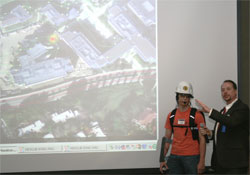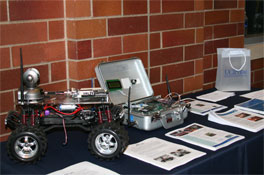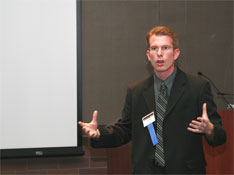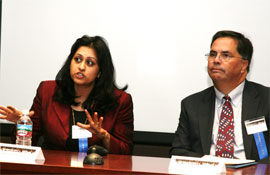Calit2@UCI Ignites Technology with Disaster Preparedness Prototypes
By Anna Lynn Spitzer
 |
|
Jonathan Cristoforetti (left) and Davison
demonstrate Evac-Pack's capabilities.
|
|
Irvine, Calif., March 6, 2007 -- Mobile, sensor-equipped robots roamed the Calit2 Atrium last week, collecting information about temperature, noise, the presence of gas and more, and sending the data – as well as audio and video streams – to local computers. The robots were one of many cutting-edge prototypes demonstrated to intrigued guests at Calit2’s fourth Igniting Technology event, Thursday, March 1, at Calit2@UCI.
“One Step Ahead of the Crisis: Innovative Technology Solutions for Disaster Preparedness” featured the latest research conducted under the auspices of a $12.5 million NSF-funded, Calit2-based project called ResCUE – Responding to Crises and Unexpected Events. Project ResCUE seeks to research and design infrastructures and products that can access, share and disseminate critical information in a timely manner to first responders during crises.
The event, which was co-sponsored by intellectual law firm Knobbe Martens Olson & Bear LLP, attracted nearly 70 members of the community. It featured a panel comprised of two UCI researchers and two community/corporate partners who are participating in the research and using the project’s test beds. Each panel member presented his/her latest findings and prototypes, before answering audience questions as a group.
The presentations and panel discussion were moderated by Knobbe Martens partner Art Rose, who specializes in technical areas including computers, mechanical devices, semiconductor fabrication, telecommunications and software.
|
|
|
|
Green (left), Venkatsubramanian and Arguelles discuss the importance of technology partnerships.
|
|
Chris Davison, UCI’s ResCUE and ResponSphere technology manager, demonstrated the project’s mobile sensor platforms, as well as Evac-Pack, a human-as-sensor contraption. The device is worn by a first responder; it gathers data from disaster scenes and automatically sends it back to emergency operations centers. Davison also shared details of UCI’s “smart spaces,” areas equipped with wired and wireless networks, cameras, a variety of sensors and sophisticated software to interpret the data. In addition, he explained the university’s test bed capabilities, which allow academic, government and corporate partners to test their prototypes and receive computerized feedback.
Jacob Green, emergency manager for the city of Ontario, Calif., collaborates with Project ResCUE researchers in the development of an interactive Web portal. The portal will make essential information available to the community during city-wide disasters.
 |
|
Mobile sensing platform and CalMesh
wireless router were displayed by UCSD
Calit2 staffer Alex Hubenko.
|
|
He demonstrated the portal’s capabilities, which include up-to-the-minute information about emergency shelters, evacuation routes, crisis control and links for locating missing relatives. Green lauded the progress achieved by the partnership. “This innovation will allow our city to interact with the community before, during and after a crisis. The partnership between the city and the university is a collaboration that allows the citizens of Ontario to have access to the highest level of public safety and disaster preparedness.”
One of Project ResCUE’s principal investigators, UCI computer sciences associate professor Nalini Venkatasubramanian, discussed the development of next-generation emergency warning systems that customize information dissemination.
“We want to deliver the right information to the right individuals in the right format, so they can generate appropriate levels of response,” she said. She cited Hurricane Katrina as an example of under-response and Hurricane Rita as an illustration of over-response. “In Katrina, people didn’t believe the warnings, so they didn’t evacuate in time. With Rita, everyone was nervous, so people in communities that weren’t in danger began evacuating, causing problems that hampered the evacuation of those who were in the disaster region.”
Venkatasubramanian discussed the multiple facets that comprise the custom dissemination effort. Technology – both sensing technology and dissemination technology – is primary; it must be tailored to capture information as it evolves in order to send the right messages to the right people.
Governmental considerations must be factored in too. “You have to determine who the decision-makers are and who has the authority to propagate these messages to the community. We want to support those decision-makers with technology that will allow them to project who is in danger, and get the right information out quickly.”
The evening’s last presenter was The School Broadcasting Company (TheSB), which develops telephone-based mass-communication systems that can reach hundreds of thousands of people simultaneously. The company is collaborating with Project ResCUE to design an early warning system for schools to alert administrators when a crisis is imminent or just beginning. “We’re fortunate to be able to tap into the resources available to us here at the university – both from a test-bed standpoint and as a way to integrate some of our products into the great work they’re doing,” said company president Evan Arguelles.





